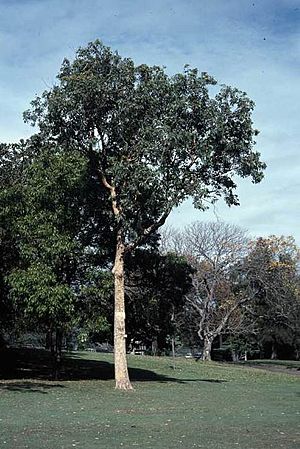Large-fruited yellowjacket facts for kids
Quick facts for kids Large-fruited yellowjacket |
|
|---|---|
 |
|
| Corymbia watsoniana in the Royal Botanic Garden, Sydney | |
| Scientific classification | |
| Genus: |
Corymbia
|
| Species: |
watsoniana
|
| Synonyms | |
|
|
The large-fruited yellowjacket (Corymbia watsoniana) is a special type of tree. It is found only in Queensland, Australia. This tree gets its name from its rough, yellowish bark. It also has large, interesting fruits.
Contents
What the Large-Fruited Yellowjacket Looks Like
This tree usually grows to be about 15 to 20 meters tall. That's like a five-story building! It has rough, flaky bark that is yellowish or brownish. This bark covers both its trunk and branches.
Young plants have dull green leaves. These leaves are shaped like an egg or a spear. They are about 12 to 21 centimeters long and 5 to 9.5 centimeters wide. Adult leaves are also dull green and egg-shaped. They can be 9 to 21.5 centimeters long and 1.8 to 6.5 centimeters wide.
The tree's flower buds grow in groups of seven. They are found at the ends of the branches. Each bud is oval-shaped, about 1.5 to 2 centimeters long. The flowers are creamy white and have been seen blooming in June.
After the flowers, the tree produces woody fruits. These fruits are shaped like a barrel or an urn. They are about 2 to 3.2 centimeters long and 1.8 to 2.4 centimeters wide.
How the Tree Got Its Name
The large-fruited yellowjacket was first described in 1877. A scientist named Ferdinand von Mueller gave it the name Eucalyptus watsoniana. He wrote about it in his book Fragmenta Phytographiae Australiae.
The name watsoniana honors "Th. Wentworth Watson." He was the person who collected the first samples of this tree. These samples were found near a place called Wigton.
Later, in 1995, two other scientists changed its name. Ken Hill and Lawrie Johnson moved it to the Corymbia group. They published this change in a science journal called Telopea.
Where the Tree Grows
This type of eucalypt tree grows in forests. It prefers flat areas where the soil is sandy. You can find it in Queensland, Australia. It grows in areas between Springsure, Rolleston, Eidsvold, Gayndah, and the Barakula State Forest.
Images for kids



